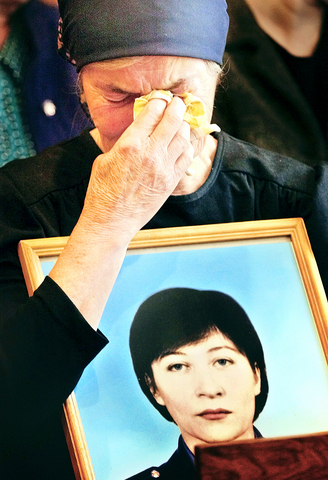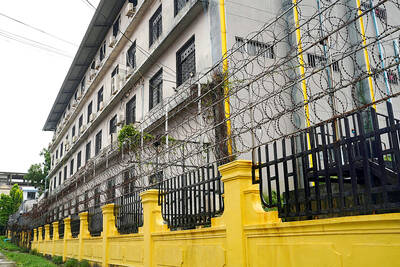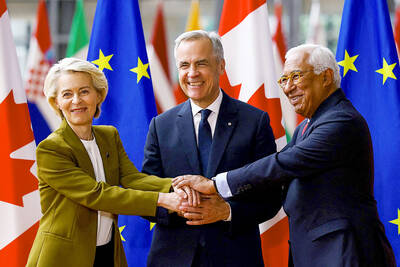As the sole trial of an alleged hostage-taker captured in the Beslan school siege opened Tuesday, several Beslan residents insisted many hostages were in fact killed by the Russian special forces who were supposed to free them.
They say the special forces used flame-throwers and rocket launchers against the school as hostages were still inside, contrary to the official version.
And they say they can prove it.

PHOTO: AP
Officially, many of the 330 people, more than half of them children, who died in the attack last September were killed by powerful explosives the hostage-takers detonated inside the school.
But the editor of a local newspaper, Murad Kabuyev, and many Beslan residents argue that their own inquiry into the circumstances of the assault carried out by Russian forces on Sept 3 last year shows very different results.
"We know flame-throwers were used before the evacuation" of the school, says Kabuyev, a respected journalist who received an award from the Russian Journalists Union for his work on the Beslan tragedy.
He says he can display two exhibits to prove this -- a flame thrower and a rocket launcher residents found near the school.
"We know the special forces set them up on the roof of a house facing the school as early as Sept. 2. Witnesses saw them," Kabuyev says.
Kabuyev and several residents have founded an association called the Initiative Group for the Submission of Evidence to the Forces of Law and Order.
The Initiative Group demands a second inquiry into the way the special forces stormed the Beslan school. And Kabuyev says that "so far, it has not been established that two bombs went off inside the [school] gymnasium" where the hostage-takers kept their captives.
In April, the group convinced the prosecutor's office to register the flame-thrower and the rocket launcher as official exhibits.
Kabuyev sees this as a first victory and insists the group's efforts have brought about a change in the official version, which had initially denied the special forces had ever used the flame-thrower.
"We handed the exhibits to the prosecutor's office on April 4," Kabuyev says.
"At first, the prosecutor insisted that they belonged to the terrorists and he would not hear anything about the fact that they had been used by the special forces. But thanks to our efforts, his office now admits this," he says.
However, Kabuyev's optimism may be a little bit premature.
While a spokesman for the prosecutor's office did confirm his services had registered the exhibits, he ruled out the possibility that they might have been used against the hostages.
"The inquiry has established that [the weapons] were used only after the hostages were evacuated" from the school, Sergei Prokapov told reporters.
"The flame-thrower and the rocket launcher were only used around 6:00pm [on Sept 3], when all hostages had been evacuated," he said. There are no testimonies or facts contradicting this."
But the Initiative Group says it has gathered precisely such testimonies, including that of Lyudmila Dzgoyeva, who was a hostage with her two daughters, one of whom was killed.
"The explosives hung up [in the school's gymnasium by the hostage-takers] did not go off," says Dzgoyeva, 33, who, like Kabuyev, is attending the trial in Vladikavkaz.
"Just before the explosion, I saw a light outside through one of the gymnasium's windows," which could have come from a flame thrower or a grenade launcher, she says. As he attends the trial, Kabuyev notes that the lawyers of the victims' families often state that the bodies of many hostages killed were burned.

Drug lord Jose Adolfo Macias Villamar, alias “Fito,” was Ecuador’s most-wanted fugitive before his arrest on Wednesday, more than a year after he escaped prison from where he commanded the country’s leading criminal gang. The former taxi driver turned crime boss became the prime target of law enforcement early last year after escaping from a prison in the southwestern port of Guayaquil. Ecuadoran President Daniel Noboa’s government released “wanted” posters with images of his face and offered US$1 million for information leading to his capture. In a country plagued by crime, members of Fito’s gang, Los Choneros, have responded with violence, using car

CYBERCRIME, TRAFFICKING: A ‘pattern of state failures’ allowed the billion-dollar industry to flourish, including failures to investigate human rights abuses, it said Human rights group Amnesty International yesterday accused Cambodia’s government of “deliberately ignoring” abuses by cybercrime gangs that have trafficked people from across the world, including children, into slavery at brutal scam compounds. The London-based group said in a report that it had identified 53 scam centers and dozens more suspected sites across the country, including in the Southeast Asian nation’s capital, Phnom Penh. The prison-like compounds were ringed by high fences with razor wire, guarded by armed men and staffed by trafficking victims forced to defraud people across the globe, with those inside subjected to punishments including shocks from electric batons, confinement

The team behind the long-awaited Vera Rubin Observatory in Chile yesterday published their first images, revealing breathtaking views of star-forming regions as well as distant galaxies. More than two decades in the making, the giant US-funded telescope sits perched at the summit of Cerro Pachon in central Chile, where dark skies and dry air provide ideal conditions for observing the cosmos. One of the debut images is a composite of 678 exposures taken over just seven hours, capturing the Trifid Nebula and the Lagoon Nebula — both several thousand light-years from Earth — glowing in vivid pinks against orange-red backdrops. The new image

Canada and the EU on Monday signed a defense and security pact as the transatlantic partners seek to better confront Russia, with worries over Washington’s reliability under US President Donald Trump. The deal was announced after a summit in Brussels between Canadian Prime Minister Mark Carney and European Commission President Ursula von der Leyen and European Council President Antonio Costa. “While NATO remains the cornerstone of our collective defense, this partnership will allow us to strengthen our preparedness ... to invest more and to invest smarter,” Costa told a news conference. “It opens new opportunities for companies on both sides of the